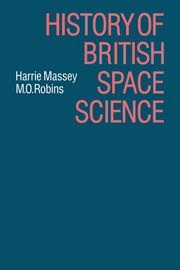Book contents
- Frontmatter
- Contents
- Glossary of abbreviations in text and annexes
- Glossary of abbreviations in appendices
- Preface
- 1 The scientific background
- 2 The technical background
- 3 The initiation of the Skylark rocket programme – the IGY and artificial satellites
- 4 Post-IGY developments – NASA – COSPAR – British National Committee for Space Research – British satellite experiments
- 5 The Ariel programme
- 6 The European Space Research Organization
- 7 Commonwealth co-operation in space reseach
- 8 Smaller rockets for scientific purposes – Skua and Petrel
- 9 Attitude controlled Skylark rockets
- 10 The Trend Committee and the Science Research Council
- 11 The transformation of ESRO into ESA
- 12 The Space Science Committee for Europe
- 13 Scientific studies by British space scientists – figure of the earth and the neutral atmosphere
- 14 Scientific studies by British space scientists – the ionosphere, the magnetosphere and cosmic rays
- 15 The contribution from British space scientists to astronomy
- 16 Concluding remarks
- Appendices
- Annexes
- Notes
- Index
14 - Scientific studies by British space scientists – the ionosphere, the magnetosphere and cosmic rays
Published online by Cambridge University Press: 05 February 2012
- Frontmatter
- Contents
- Glossary of abbreviations in text and annexes
- Glossary of abbreviations in appendices
- Preface
- 1 The scientific background
- 2 The technical background
- 3 The initiation of the Skylark rocket programme – the IGY and artificial satellites
- 4 Post-IGY developments – NASA – COSPAR – British National Committee for Space Research – British satellite experiments
- 5 The Ariel programme
- 6 The European Space Research Organization
- 7 Commonwealth co-operation in space reseach
- 8 Smaller rockets for scientific purposes – Skua and Petrel
- 9 Attitude controlled Skylark rockets
- 10 The Trend Committee and the Science Research Council
- 11 The transformation of ESRO into ESA
- 12 The Space Science Committee for Europe
- 13 Scientific studies by British space scientists – figure of the earth and the neutral atmosphere
- 14 Scientific studies by British space scientists – the ionosphere, the magnetosphere and cosmic rays
- 15 The contribution from British space scientists to astronomy
- 16 Concluding remarks
- Appendices
- Annexes
- Notes
- Index
Summary
As we have explained in Chapter 1, the British scientists who were most interested initially in the use of rockets for scientific research were those concerned with the ionosphere so it is not surprising that, since the inception of a rocket research programme, a great deal of attention has been directed towards ionospheric studies. This has involved the use of a wide variety of techniques ranging from ground-based radio tracking of satellites to in situ measurements of ionospheric properties from space vehicles. In fact, as we shall see, much of the work has been concerned with the topside ionosphere and this has naturally connected up with studies of the magnetosphere to which many ionospheric physicists have made major contributions.
Ways and means
At the time when these programmes were planned, most knowledge of the ionosphere was confined to the information obtained from ground-based sounding which basically provided the height profile of electron concentration above the sounding station. Even this was incomplete as explained in Chapter 1, p. 2, especially as it could provide no information about the region above the F layer maximum – the topside ionosphere. No direct method of determining other important ionospheric parameters such as the electron temperature or the positive ion composition was available. By the early 1950s the impact of the new rocket techniques was making itself felt in that exploratory measurements had been made, particularly of the ion composition and of the electron concentration in the gaps in the altitude profile.
- Type
- Chapter
- Information
- History of British Space Science , pp. 297 - 338Publisher: Cambridge University PressPrint publication year: 1986



